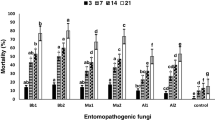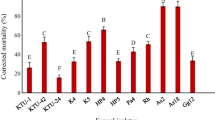Abstract
The outbreak areas of the red locust are seasonally inundated wetland areas supporting a rich biodiversity. The potential for environmental damage from the repeated use of broad-spectrum insecticides for locust control in these ecologically sensitive wetlands is therefore great. This paper describes the first trial of a Metarhizium anisopliae var. acridum (LUBILOSA isolate IMI 330189) mycoinsecticide as an alternative, more environmentally benign, intervention strategy for managing red locust populations in their outbreak areas. Following initial bioassay tests in the laboratory, which gave 90–93% kill of 3rd instar hoppers within 6–9 days, an oil based formulation of aerial conidia was applied at a rate of 5 × 1012 conidia /ha using a motorised ‘Solo’ knapsack sprayer to treat 3rd and 4th instar hopper bands in the Buzi outbreak area near Beira in Mozambique. Caged samples of 3rd instars succumbed quickly with a median time to kill of 3.6–3.9 days and 98–100% kill recorded within 8–9 days. The 4th instars took longer to die, with a median lethal time of 5.96.1 days and > 90% mortality after 21 days. Mortality in control samples was low with 13–23% mortality after 21 days. During this mortality assessment period mean minimum and maximum air temperatures ranged from 26–34°C and relative humidity ranged from 85–100%. Observations on treated bands in the field showed that the cohesion of the 3rd instar bands broke down within 6 days, while controls still behaved normally. Unfortunately observations on the 4th instar band had to be terminated after 10 days due to heavy flooding. This preliminary field trial demonstrated the feasibility of using a Metarhizium mycoinsecticide, applied through conventional spray equipment, for controlling the red locust in its outbreak areas.
Résumé
Les foyers de reproduction et d’essaimage du criquet rouge envahissent saisonnièrement les zones humides abritant une riche diversité en espèces. Les risques de dégradation de l’environnement lors des efforts répétés d’utilisation des pesticides à large spectre dans la lutte contre le criquet deviennent grands dans ces zones humides écologiquement sensibles. Cet article décrit les premiers essais de lutte antiacridienne par emploi de Metarhizium anisopliae var. acridum (isolat IMI330189 de LUBILOSA). Ce myco-insecticide est employé en guise d’une altémative moins polluante au point de vue environnement et comme une stratégie d’intervention de contrôle des populations du criquet rouge dans les foyers de reproduction. Partant des premiers essais de laboratoire qui ont donné lieu à 90–93% de mortalité chez les larves de troisième stade endéans 6–9 jours, une formulation huileuse à base de conidies a été appliquée au moyen d’un pulvérisateur à dos de marque Solo et à une concentration de 5 x 1012 conidies/ha pour le traitement des bandes de larves de 3ème et 4ème dans le site de reproduction grégarigène de Buzi près de Beira au Mozambique. Des échantillons de larves encagées de 3ème stade succombaient rapidement sous l’action du produit dans un intervale de 3,6–3,9 jours et on enregistrait 98–100% de mortalité endéans 8–9 jours. Les larves de 4ème stade ont mis un temps relativement long pour mourir dans un interval moyen de 5,9–6,1 jours et leur mortalité était de moins de 91% après 21 jours. Chez les témoins une basse mortalité de 13–23% était observée après 21. Au cours de l’expérience sur la mortalité, les températures minima et maxima de l’air se rangeaient entre 26–34°C tandis que l’humidité relative entre 85–100%. Les observations sur les bandes larvaires traitées en champs ont montré que la cohésion des bandes de larves de 3ème stade se dissolvait endéans 6 jours, pendant que les larves témoins se comportaient normalement. Malheureusement les observations sur les bandes de larves du 4ème stade ont dû se faire après 10 jours suite aux fortes inondations qui prévalaient. Les essais préliminaires en champs ont prouvé la possibilité d’utiliser un myco-insecticide à base de Metarhizium une fois que celui-ci est appliqué par des moyens classiques.
Similar content being viewed by others
References
Bahana J. W. and Byaruhanga E. K. (1991) IRLCO-CSA; Perspectives and prospects of biological control of the red locust, Nomadacris septemfasciata, pp. 57–63. In Biological Control of Locusts and Grasshoppers (Edited by C. J. Lomer and C. Prior). CABI, Wallingford.
Bateman R. R, Carey M., Moore D. and Prior C. (1993) The enhanced infectivity of Metarhizium flavoviride in oil formulations to desert locusts at low humidities. Ann. Appl. Biol. 122, 145–152.
Bateman R. R, Price R. E., Müller E. J. and Brown H. D. (1994) Controlling brown locust hopper bands in South Africa with a myco-insecticide spray. Brighton Crop Protection Conference—Pests and Diseases. 6A-3, 609–616.
Brown H. D. (1973) Red locust situation in central Mozambique: June 1973. Report on a combined Mozambique, Rhodesia and South African survey: 11–22 June. PPRI, Pretoria.
Chapman R. F. (1959) Field observations on the behaviour of hoppers of the red locust, Nomadacris septemfasciata (Serville). Anti-Locust Bull. 33, 51 pp.
Dean G. J. W. (1967) Observations on the structure of hopper bands and movement of hoppers of the red locust, Nomadacris septemfasciata (Serville). J. Ent. Soc. S. Afr. 30, 1–17.
Driver E., Milner R. F. and Trueman W. H. (2000) A taxonomic revision of Metarhizium based on a phylogenetic analysis of ribosomal DNA sequence data. Mycological Research (in press).
Faure J. C. (1935) The life history of the red locust (Nomadacris septemfasciata (Serville)). Bull. Dept. Agrie. S. Afr. 144, 5–32.
Fernandes J. F. (1969) Os solos de entre o Pungué e o Buzi. Sua aptidäo par o regadío. Comunicaçôes 30. INIA, Mozambique.
Gunn D. L. (1960) Nomad encompassed. J. Ent. Soc. S. Afr. 23, 65–125.
Lea A. and Webb V. van (1939) Field observations on the red locust at Lake Rukwa in 1936–1937. Sci. Bull. Dept. Agrie. For. S. Afr. No. 189, 3–81.
Lomer C. J., Prior C. and Kooyman C. (1997) Development of Metarhizium spp. for the control of grasshoppers and locusts. Mem. Entomol. Soc. Canada 171, 265–286.
Morant V. (1947) Migrations and breeding of the red locust, Nomadacris septemfasciata (Serville) in Africa, 1927–1945. Anti-Locust Mem. 2. pp. 4–60.
Pole Evans I. B. (1911) The South African locust fungus. Farm. Bull., Dep. Agrie., Un. S. Afr. No. 82.
Prior C., Carey M., Abraham Y. J., Moore D. and Bateman R. P. (1995) Development of entomopathogenic fungi virulent to the desert locust, Schistocerca gregaria. J.. Appl. Ent. 119, 567573.
Price R. E., Bateman R. R, Brown H. D., Butler E. T. and Müller E. J. (1997) Aerial spray trials against brown locust, Locustana pardalina Walker, nymphs in South Africa using oil-based formulations of Metarhizium flavoviride. Crop Protection 16, 345–351.
Schaefer E. E. (1936) The white fungus disease (Beauveria bassiana) among red locusts in South Africa, and some observations on the grey fungus disease (Empusa grylli). Sci. Bull: Dept. Agrie. For. S. Afr. 160, 28 pp.
Skaife S. H. (1925) The locust fungus, Empusa grylli, and its effects on its host. S. Afr. J. Sci. 22, 298–308.
Smee C. (1936) Notes on the red locust (Nomadacris septemfasciata Serv) in Nyasaland 1933–34. Bull. ent. Res. 27, 15–35.
Steedman A. (1990) The Locust Handbook. (3rd edn.) Natural Resources Institute, Chatham.
Stortenbeker C. W. (1967) Observations on the population dynamics of the red locust, Nomadacris septemfasciata (Serville), in its outbreak areas. Instituut voor Toegepast Biologisch Ondorzoek in de Natuur Mededeling. No. 84, 118 pp.
Symmons P. M. (1959) The effect of climate and weather on the numbers of the red locust in the Rukwa Valley outbreak area. Bull. ent. Res. 50, 507–521.
Symmons P. M. and Carnegie A. J. M. (1959) Some factors affecting breeding and oviposition of the red locust, Nomadacris septemfasciata (Serv.). Bull. ent. Res. 50, 333–335.
Vesey-Fitzgerald D. F (1955) The vegetation of the outbreak areas of the red locust (Nomadacris septemfasciata Serv.) in Tanganyika and Northern Rhodesia. Anti-Locust Bull. 20, 1–31.
Uvarov B. P. (1942) The locust plague. R. Soc. Arts. 8 pp.
Author information
Authors and Affiliations
Corresponding author
Rights and permissions
About this article
Cite this article
Price, R.E., Müller, E.J., Brown, H.D. et al. The First Trial of a Metarhizium anisopliae var. acridum Mycoinsecticide for the Control of the Red Locust in a Recognised Outbreak Area. Int J Trop Insect Sci 19, 323–331 (1999). https://doi.org/10.1017/S1742758400018956
Accepted:
Published:
Issue Date:
DOI: https://doi.org/10.1017/S1742758400018956
Key Words
- red locust
- Nomadacris septemfasciata
- Metarhizium anisopliae var. acridum
- mycoinsecticide
- laboratory bioassay
- field trials




